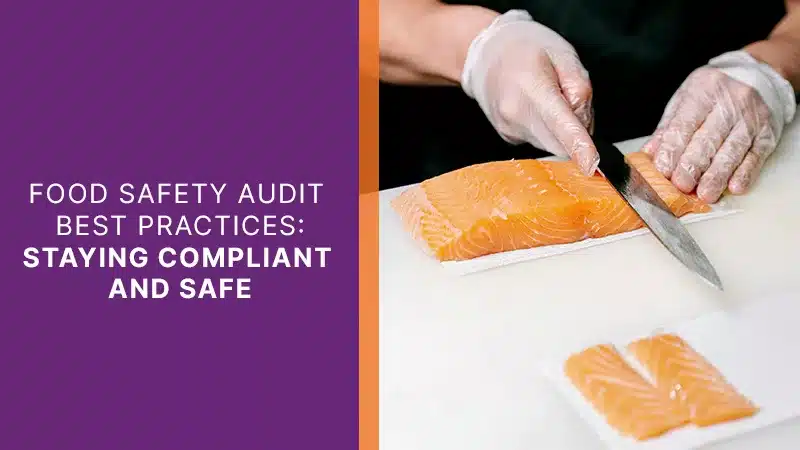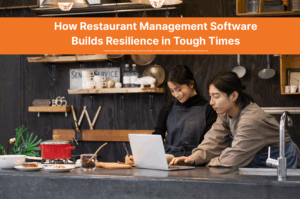To state it simply: foodborne illnesses can harm public health and erode trust in your brand. Foodborne illnesses can harm public health and erode trust in your brand. For restaurants, staying on top of food safety audits is critical to compliance and quality.
Foodborne illness can have serious implications from rapidly eroding consumer confidence to drawing the critical eye of regulatory agencies which can result in hefty fines. For restaurants, ensuring food safety and regulatory compliance is more crucial than ever.
With the increasing complexity of food production and distribution, maintaining high standards through regular audits is essential for protecting consumers and businesses alike.
Inspections and audits may seem like the same thing, but there are some key differences that are critical to know so that both can be used effectively.
This guide outlines practical steps to ensure you’re always audit-ready while improving food safety standards.
By implementing these strategies, businesses can ensure compliance and enhance the quality of their products, ultimately safeguarding public health.
Internal Audits vs. External Audits
Internal audits are first-party assessments within an organization aimed at self-evaluation and continual improvement of food safety management systems. They help identify areas of non-compliance and enable businesses to implement corrective actions promptly.
In contrast, external audits include other parties like your suppliers and your vendors. These are performed to evaluate the compliance and practices of suppliers or associated businesses. Both types of audits can highlight trends and issues, helping organizations bolster their overall performance.
In short:
- Internal audits = self-assessment for improvement.
- External audits = external checks (e.g., suppliers, third parties) to ensure compliance.
Audits vs. Inspections
In the United States, regulatory bodies like the FDA or USDA conduct inspections to evaluate compliance with safety regulations. State and municipal governments usually have their own regulatory requirements and regular, regulatory audits in addition.
Audits, on the other hand, take place internally and are used by restaurants to ensure that they are compliant with the standards that are set and evaluated during inspections.
- Inspections = evaluations for compliance by outside agencies like departments of health
- Ausits = internal evaluations conducted by an organization
Both audits and inspections aim to ensure adherence to food safety plans and maintain cleanliness. However, audits provide a long-term evaluation, whereas inspections focus more on current conditions.
For example, say you have a freezer that is on the fritz but hasn’t broken down yet. A random inspection of your restaurant’s cold storage facilities by your local health department may or may not reveal this. The inspection confirms compliance at that moment, but the issue is still there.
On the other hand, regular audits of your cold storage equipment conducted by you would include recording metrics like temperature and alerting you that your freezer isn’t running as cold as it was the last time it was audited.
Think of passing inspections made by outside agencies with flying colors as the incentive for regular internal audits. Pairing audits with inspections creates powerful synergies that can preempt major problems.
How to be Perennially Prepared for an Audit
Being perpetually prepared for an audit involves consistent adherence to established food safety practices. The best way to prepare for an audit is to shift your thinking paradigm away from preparing for audits to setting and keeping high-quality standards as part of regular business.
When food safety compliance, good hygiene, and proper cleaning and maintenance are just part of your company culture, then an audit or inspection isn’t an event, it’s just another Tuesday.
Companies should foster a culture of accountability and ownership among staff, ensuring everyone understands their role in upholding safety standards.
Have a Culture of Food Safety
Developing a strong food safety culture involves engaging employees in compliance with food safety before, during, and after audits. Interviewing them and promoting ownership instills confidence and a sense of responsibility.
Having a company culture where the safety of food is paramount, where the very idea of cross-contamination of food is unthinkable, where correct answers to auditor questions are part of daily communication, where other restaurants’ “corrective actions” are standard procedure, and where noncompliance with food safety carries a genuine stigma means that food safety auditing isn’t something to be dreaded.
A good way to accomplish this is to incorporate food safety into daily conversation.
Whenever you have a pre-shift staff meeting, make it a point to emphasize some element of food safety for the staff to consider throughout the day. Making a cycling list of topics of discussion can make sure that these important things aren’t forgotten.
Doing all of this creates a sense of ownership and confidence among all employees.
Preparing for audits through pre-audits and practice responses enhances this culture and reduces the likelihood of mistakes by evenly dividing tasks among employees. Regular audits identify areas for improvement and offer training opportunities, reinforcing commitment to safety standards.
Train and Retrain Employees
Employees play a critical role in food safety and, by extension, passing external and internal food safety audits. Proper and regular training is pivotal in food handling, storage, facility maintenance, and personal hygiene practices upholding food safety standards.
Inadequate training can lead to critical errors, compromising food safety. Ensure employees receive sufficient initial, elementary training in food safety policies and practices.
Beyond that, regular refreshers on compliance with food safety standards will help shore up this commitment to food safety.
When audit time comes, staff meetings can confirm understanding and boost preparedness. Internal audits also serve as training tools, enhancing employees’ grasp of their roles in maintaining compliance.
Employ a Food Safety Expert
Having a dedicated food safety auditor (or somebody with this skillset in addition to other roles) is crucial in evaluating the sanitation and operation of food facilities.
An auditor assesses environmental factors and training practices, identifying areas for improvement. Internal audits help proactively resolve non-conformities and ensure readiness for external audits.
Robust documentation systems are essential to maintain compliance, emphasizing detailed and organized record-keeping.
Conduct Regular Internal Audits and Inspections
Conducting regular internal audits identifies non-compliance areas, such as poor storage or handling. They facilitate prompt corrective actions, improving food safety management systems. Internal audits also train employees about their responsibilities, reducing the risk of foodborne illnesses and contamination. This continuous improvement fosters consumer trust and maintains a competitive edge.
Properly Clean and Maintain all Food Storage and Prep Areas
Maintaining correct food storage temperatures is crucial to prevent bacterial growth and contain the risk of contamination.
Regularly clean all food preparation devices and surfaces, whether daily, hourly or after a specific action.
Regularly inspect all refrigerators, freezers, pantries, and other facilities where any food product is stored. Check temperatures and make sure that all components are working. Malfunctioning equipment isn’t just a source of food safety hazards, they’re potentially very expensive repairs, and routine maintenance can prevent both.
Have Checklists and other Documentation
Every restaurant should have established food safety management protocols. Comprehensive checklists ensure all relevant areas, like processes and quality control, are systematically reviewed in preparation for and during audits.
For example, in a busy kitchen, it can be easy to forget what piece of equipment was used to process a particular type of food or on what surface something like poultry or fish was prepared.
Cross-contamination of food is usually accidental so creating a checklist or process and training your staff in it can prevent if from happening.
Further, accurately gathering documentation helps you identify improvement areas, keeping audits transparent and aligned with industry standards and regulations. Regular updates to these records are essential for ongoing audit preparedness.
Use Technology to Tie it All Together
Managing food safety across locations can be challenging, but technology makes it easier.
At SynergySuite, we combined our years of expertise in the restaurant and software industries to develop intuitive software solutions that help manage inventory, create checklists, and track employee training.
Centralizing data and documentation on our award-winning suite of applications simplifies compliance. It enhances the efficiency of food safety management, and it’s manageable from your desktop or mobile device.
Embracing our powerful technological tools supports a cohesive, organized approach to maintaining high safety standards across your food supply chains, helps ensure your compliance with food safety regulations, makes uniform quality management across multiple locations much easier, and makes both internal and external food safety audit processes a breeze.Take the stress out of food safety! Contact us today so we can set up a free, personalized demo. Learn how SynergySuite can help you manage every critical aspect of your business.






